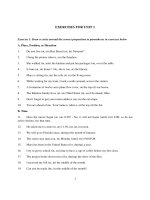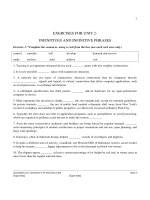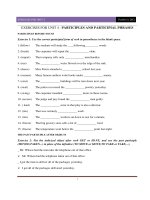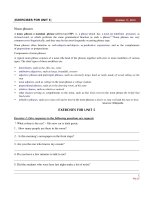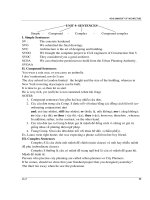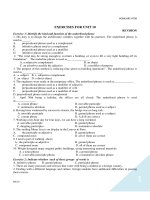Architecture English Exercise Unit 01
Bạn đang xem bản rút gọn của tài liệu. Xem và tải ngay bản đầy đủ của tài liệu tại đây (32.82 KB, 5 trang )
1
EXERCISES FOR UNIT 1
Exercise 1: Draw a circle around the correct preposition in parentheses in exercises below
A. Place, Position, or Direction
1. Do you live (at, on) Bay Street (on, in) Newport?
2. I hung the picture (above, on) the fireplace.
3. She walked (in, into) the kitchen and put her packages (on, over) the table.
4. Is Jane (at, in) home? -No, she is (on, at) the library.
5. Mary is sitting (in, on) the sofa (at, in) the living room.
6. While waiting for my train, I took a walk (around, across) the station.
7. A formation of twelve aero plane flew (over, on the top of) our house.
8. The Blacken family lives (at, on) Third Street (in, on) Cleveland, Ohio.
9. Don’t forget to put your return address (on, in) the envelope.
10. You are ahead of me. Your name is (above, at the top of) the list.
B. Time
11. Does the movie begin (at, on) 6:30? - No, it will not begin (until, for) 9:00; so do not
arrive (before, by) that time.
12. He asked me to come (in, at) 11:30, not (at, in) noon.
13. We will go to Florida (since, during) the month of January.
14. The stores stay open (on, in) Monday (until, for) 9:00 P.M.
15. Mary has been in the United States (for, during) a year.
16. I try to get to school (in, on) time to have a cup of coffee before my first class.
17. The project broke down twice (for, during) the show of the film.
18. I received my bill (to, in) the middle of the month.
19. Can you be ready (by, in) the middle of the month?
2
20. We plan to finish this project (around, until) the first of the year.
C. Miscellaneous
21. We accept your kind invitation (by, with) pleasure.
22. I would like to read that book (by, of) Ernest Hemingway.
23. These oranges are sold (of, by) the dozen.
24. The door (of, at) the house is painted red.
25. He says he can communicate (by, of) mental telepathy.
26. Always sign important papers (by, in) ink.
27. Would you rather write (by, with) a pen or pencil?
28. Over one-third (of, in) the oranges are spoiled.
29. Would you like to go (by, with) us (by, in) our car?
30. He always speaks (in, by) a loud voice.
Exercise 2: Draw a circle around the correct preposition in parentheses in the following
paragraphs
1. John Doe, who graduated (of, from) the University of North Carolina two years ago, is now
doing graduate work (in, on) engineering (at, to) Georgia Tech. He expects to receive his
Master’s degree (by, in) next June. After that, he plans to accept a job (as, like) a technician (by,
with) an oil company (in, at) South America.
2. Jim was walking (across, over) the campus (in, at) noon when he met a friend whom he had
not seen (since, during) summer. They stopped (in front of, around) the gymnasium and sat down
(in, on) the steps. After they had talked (for, during) about ten minutes, Jim said,” I must go
(toward, to) the library and take out some books. I have a test in history (in, on) Friday. I’m
living (to, in) Jefferson Hall this semester. Why don’t you drop by some afternoon (over, after)
class? “.
3. Mr. Hill arrived in New York (on, in) May 10 (at, on) 8 o’clock (in, on) the evening. He
decided to call on his uncle who lives (on, in) Fifth Avenue. He got on a bus (at, of) the station
and put his fare (on, into) the fare box, the bus was very crowded, so Mr. Hill had to stand up all
the way.
When he reached 85th Street, Mr. Hill got off the bus and walked a short distance (in, to) the
apartment building (in, of) which his uncle lived. He knocked (at, in) the door, (of, on) his
3
uncle’s apartment. He waited (for, during) a few minutes, but no one came (to, on) the door. He
was disappointed to find no one (to, at) home. He didn’t know where to go because his uncle had
promised to reserve a room for him (at, by) a down town hotel. He saw a bench (at, to) the end of
hall, and he sat down (on, in) it to wait for his uncle.
Exercise 3: Underline and identify prepositional phrases in the following sentences
1. Building design is the process of providing all information necessary for construction of a
building that will meet its owner’s requirements and also satisfy public health, welfare, and
safety requirements.
2. Building construction is the process of assembling materials to form a building.
3. Competency is determined on the basis of education and experience.
4. Most architects devote their time to commercial construction projects such as schools, offices,
and hospitals.
5. An architect is responsible for the design of a structure and for the building environment.
6. The Babylonians discovered the technique of making bricks by burning clay.
7. A more important reason for its continuing popularity lies in the close relationship between
man and the material.
8. They could be used for load-bearing walls in much the same way as the stone buildings that
they superseded.
9. In their most common form, they rust and decay after prolonged exposure in damp
atmosphere.
10. In a concrete skyscraper the floors can be made from solid, flat slabs, leaving more headroom
for the pipework and airducts.
Exercise 4: Tell the function of the following underlined prepositional phrases
1. In modern building construction, foundations are usually of concrete.
A. a noun modifier B. an adverb modifier
C. a complement D. a sentence modifier
2. They traveled around the world by ship.
A. a noun modifier B. a verb modifier
C. a complement D. an adjective modifier
4
3. Civil engineering is a form of human activity.
A. a noun modifier B. a verb modifier
C. a complement D. an adverb modifier
4. He came home in bad temper.
A. a noun modifier B. a verb modifier
C. a complement D. a sentence modifier
5. In a warehouse, the goods stored there form the chief load.
A. a noun modifier B. a verb modifier
C. a complement D. a sentence modifier
6. He was very good with children.
A. a noun modifier B. a verb modifier
C. a complement D. an adjective modifier
Exercise 5: Fill in the blank with the suitable preposition
Wright, Frank Lloyd (1867-1959), American architect, considered one of the greatest figures of
20th-century architecture. However, both the man and his work were controversial ______ his
lifetime.
Wright was born either ______ Richland Center, or in nearby Bear Valley, Wisconsin, and grew
up largely ______ the tutelage of his mother, Anna, and his aunts and uncles on farmland ______
Spring Green, Wisconsin. His father, a musician, abandoned the family in 1885. Wright briefly
studied engineering ______ the University of Wisconsin, displaying a knack for drawing, and in
1887 he moved to Chicago, Illinois. ______1888 ______ 1893 he worked as an assistant ______
the Chicago architectural firm of Adler and Sullivan, learning much ______ embarking on an
independent architectural path _____ 1893.
______ His trips to Japan, Wright frequently stopped ______ California, and ______ the early
1920s he joined his architect son Lloyd Wright ______ southern California. There he designed
four houses built of patterned concrete blocks. Steel reinforcing rods knit the blocks together to
form walls ______ what Wright called a textile block system.
Aside from Fallingwater, the building ______ which Wright is most remembered is the
Guggenheim Museum (1957-1959) ______ New York City. Its spiraling ramp provides a
5
dramatic setting ______ art, although critics have questioned the ramp’s suitability as an
exhibition space.
He continued working ______ his death, two months ______ his 92nd birthday. Architects
worldwide now employ grid systems as well as the open type of floor plan he pioneered. The
originality ______ Wright’s designs, his sensitivity to a building’s surroundings, and his creative
use of materials—especially concrete and cement blocks—have been widely recognized. A
number ______ his buildings are considered national landmarks.
Exercise 6: further reading
An architect is a person trained and experienced in the design of buildings and the coordination
and supervision of all aspects of the construction of buildings.
An architect must be creative and practical, and have an understanding of structure, materials,
aesthetics, costs, regulations, the construction industry and the personal tastes and needs of a
client.
The architect must be able to negotiate through these sometimes conflicting elements to provide
a creative solution to a brief, and to bring the solution from idea to reality.
It is the juggling of these various elements that gives the profession its interest and excitement.
The wide range of activities in the practice of architecture allows individuals to specialize in the
areas where they have the most skill and expertise, but all architects must be proficient in all
areas of the profession.
What is the role of the architect?
The role of the architect has changed over the centuries, from being head builder to becoming the
leader of a team of consultants involved in the process of designing a building, and ensuring it is
constructed in accordance with the design.
An architect may be the partner of a firm, a sole practitioner, and an employee in an architectural
practice, an architect in the public service or an academic at an institution.
THE END
